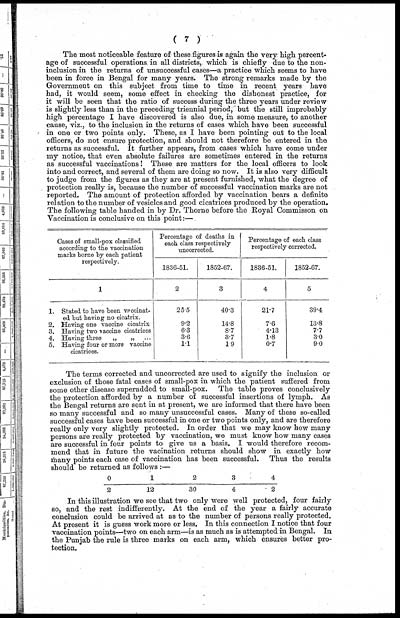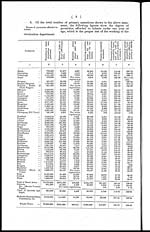Medicine - Vaccination > 1887-1898 - Annual statistical returns and brief notes on vaccination in Bengal > 1893-1896 - Triennial report of vaccination in Bengal during the years 1893-96
(363) Page 7
Download files
Individual page:
Thumbnail gallery: Grid view | List view

( 7 )
The most noticeable feature of these figures is again the very high percent-
age of successful operations in all districts, which is chiefly due to the non-
inclusion in the returns of unsuccessful cases—a practice which seems to have
been in force in Bengal for many years. The strong remarks made by the
Government on this subject from time to time in recent years have
had, it would seem, some effect in checking the dishonest practice, for
it will be seen that the ratio of success during the three years under review
is slightly less than in the preceding triennial period, but the still improbably
high percentage I have discovered is also due, in some measure, to another
cause, viz., to the inclusion in the returns of cases which have been successful
in one or two points only. These, as I have been pointing out to the local
officers, do not ensure protection, and should not therefore be entered in the
returns as successful. It further appears, from cases which have come under
my notice, that even absolute failures are sometimes entered in the returns
as successful vaccinations! These are matters for the local officers to look
into and correct, and several of them are doing so now. It is also very difficult
to judge from the figures as they are at present furnished, what the degree of
protection really is, because the number of successful vaccination marks are not
reported. The amount of protection afforded by vaccination bears a definite
relation to the number of vesicles and good cicatrices produced by the operation.
The following table handed in by Dr. Thorne before the Royal Commisson on
Vaccination is conclusive on this point:—
|
Cases of small-pox classified |
Percentage of deaths in |
Percentage of each class |
||
|
1836-51. |
1852-67. |
1836-51. |
1852-67. |
|
|
1 |
2 |
3 |
4 |
5 |
|
1. Stated to have been vaccinat- |
25.5 |
40.3 |
21.7 |
39.4 |
|
2. Having one vaccine cicatrix |
9.2 |
14.8 |
7.6 |
13.8 |
|
3. Having two vaccine cicatrices |
6.3 |
8.7 |
4.13 |
7.7 |
|
4. Having three „ „ |
3.6 |
3.7 |
1.8 |
3.0 |
|
5. Having four or more vaccine |
1.1 |
1.9 |
0.7 |
9.0 |
The terms corrected and uncorrected are used to signify the inclusion or
exclusion of those fatal cases of small-pox in which the patient suffered from
some other disease superadded to small-pox. The table proves conclusively
the protection afforded by a number of successful insertions of lymph. As
the Bengal returns are sent in at present, we are informed that there have been
so many successful and so many unsuccessful cases. Many of these so-called
successful cases have been successful in one or two points only, and are therefore
really only very slightly protected. In order that we may know how many
persons are really protected by vaccination, we must know how many cases
are successful in four points to give us a basis. I would therefore recom-
mend that in future the vacination returns should show in exactly how
many points each case of vaccination has been successful. Thus the results
should be returned as follows :—
|
0 |
1 |
2 |
3 |
4 |
|
2 |
12 |
30 |
4 |
2 |
In this illustration we see that two only were well protected, four fairly
so, and the rest indifferently. At the end of the year a fairly accurate
conclusion could be arrived at as to the number of persons really protected.
At present it is guess work more or less. In this connection I notice that four
vaccination points—two on each arm—is as much as is attempted in Bengal. In
the Punjab the rule is three marks on each arm, which ensures better pro-
tection.
Set display mode to: Large image | Zoom image | Transcription
Images and transcriptions on this page, including medium image downloads, may be used under the Creative Commons Attribution 4.0 International Licence unless otherwise stated. ![]()
| India Papers > Medicine - Vaccination > Annual statistical returns and brief notes on vaccination in Bengal > Triennial report of vaccination in Bengal during the years 1893-96 > (363) Page 7 |
|---|
| Permanent URL | https://digital.nls.uk/91538967 |
|---|




